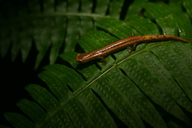|
Bolitoglossa mombachoensis Köhler & McCranie, 1999
Salamandra de Mombacho Subgenus: Bolitoglossa | family: Plethodontidae subfamily: Hemidactyliinae genus: Bolitoglossa |
 © 2014 Tariq Stark (1 of 26) |
|
|
|
Description In life, there is some color variation between individuals. One female was recorded as having cinnamon brown dorsal surfaces of the head and body with indistinct dark brown (Vandyke brown) mottling and longitudinal lines. The dorsal surfaces of the limbs were Vandyke brown and the dorsal surface of the tail was a dull cinnamon (sayal brown) with Vandyke brown mottling. Lateral surfaces had an incomplete tawny olive longitudinal stripe, bordered below by Vandyke brown. The ventral surfaces were brown with fine pale longitudinal lines. The iris was ferruginous. Another individual (also female) was recorded as having fawn-colored dorsal surfaces of the head and body shading into olive brown laterally. The lateral longitudinal band was clay-colored and bordered below by dark olive brown (Prout's brown). The dorsal surfaces of the limbs were Prout's brown and the dorsal surface of the tail was fawn-colored. The iris was cinnamon. The color of specimens in preservative is described as brown to dark brown, often streaked with a paler brown. Some individuals have a suggestion of a longitudinal stripe shown by a paler mid-dorsal region. In most specimens, the pale brown dorsolateral stripe extends from behind the upper eyelid to the hind limb insertion. The stripe may be faint, irregular, or incomplete. The dorsal tail color is pale to dark brown and as with the body, some individuals have a tail with a paler mid-dorsal region that suggests a longitudinal stripe. The lateral tail color is brown to dark brown and often streaked with an even paler brown. The dorsal limb surface color is brown to dark brown and has no distinctive markings. The ventral surface of the head and the body are dotted heavily with spots of dark brown. The pattern sometimes is absent to form pale streaks which vary from long and numerous to few and short (Köhler and McCranie 1999). Distribution and Habitat Country distribution from AmphibiaWeb's database: Nicaragua
Life History, Abundance, Activity, and Special Behaviors Vences and Schmitt (1991, as B. striatula) found several clutches of eggs in August in leaf litter, but females were not found in close proximity. Two clutches contained 16–22 eggs and one clutch started to hatch a week after collection. The other, however, did not start to hatch until early December (Köhler and McCranie 1999). Trends and Threats Possible reasons for amphibian decline General habitat alteration and loss Comments
References
Köhler, G., McCranie, J. R. (1999). ''A new species of salamander from Volcán Mombacho, Nicaragua, formerly referred to Bolitoglossa striatula.'' Senckenbergiana biologica, 79(1), 89-93. Noble, G. K. (1918). ''The amphibians collected by the American Museum Expedition to Nicaragua in 1916.'' Bulletin of the American Museum of Natural History, New York, 38, 311-347. Stuart, S., Hoffmann, M., Chanson, J., Cox, N., Berridge, R., Ramani, P., Young, B. (eds) (2008). Threatened Amphibians of the World. Lynx Edicions, IUCN, and Conservation International, Barcelona, Spain; Gland, Switzerland; and Arlington, Virginia, USA. Vences, M., and Schmitt, R. (1991). ''Herpetologische Beobachtungen in Nicaragua. Die Amphibien.'' Herpetofauna (Weinstadt), 13 (Supplement 75), 21-26. Originally submitted by: Mae Huo (first posted 2009-09-28) Edited by: Kellie Whittaker (2009-10-12) Species Account Citation: AmphibiaWeb 2009 Bolitoglossa mombachoensis: Salamandra de Mombacho <https://amphibiaweb.org/species/5339> University of California, Berkeley, CA, USA. Accessed Jun 14, 2025.
Feedback or comments about this page.
Citation: AmphibiaWeb. 2025. <https://amphibiaweb.org> University of California, Berkeley, CA, USA. Accessed 14 Jun 2025. AmphibiaWeb's policy on data use. |




 Raffaëlli Account
Raffaëlli Account Map of Life
Map of Life